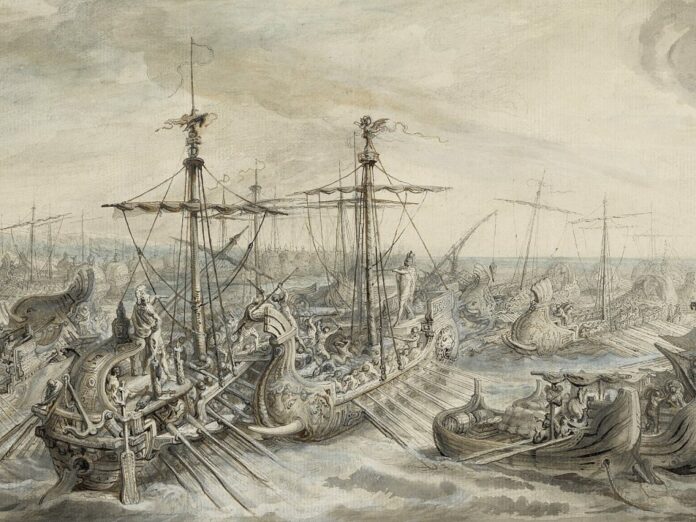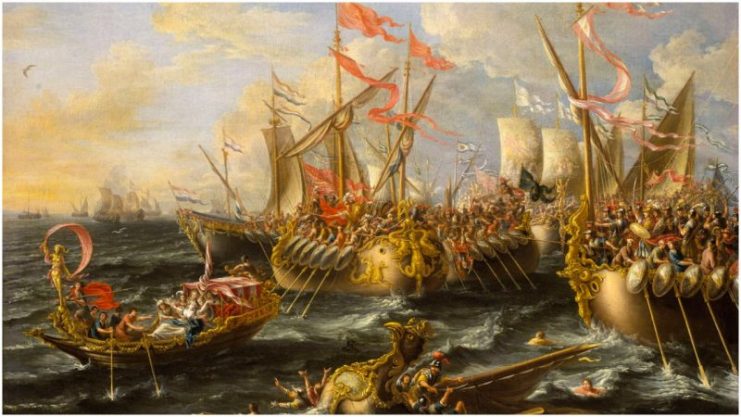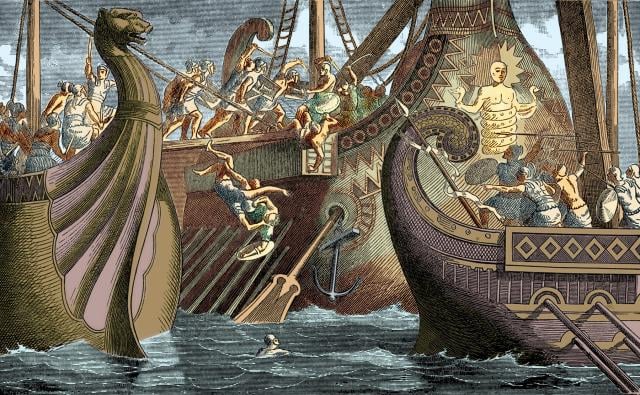The Battle of Cape Ecnomus: Rome’s Unlikely Victory in the First Punic War

In 256 BC, amidst the turbulence of the First Punic War (264-241 BC), one of the most significant naval engagements of ancient history unfolded near the coast of Sicily, Italy. Known as the Battle of Cape Ecnomus, this monumental clash saw the forces of Rome and Carthage engage in a fierce struggle for dominance over the Mediterranean Sea. This article delves into the details of this historic battle, exploring its context, the key participants, and the factors that led to Rome’s surprising victory.
Context and Forces Involved

The First Punic War marked a defining period in the struggle for control of the Mediterranean between Rome and Carthage. By 256 BC, Rome was eager to challenge Carthage’s dominance, and the Roman fleet, boasting approximately 330 ships, was dispatched from Sicily with the intention of striking at the heart of Carthage in Africa. However, their path crossed with a formidable Carthaginian fleet of 350 ships near the coast of what is now modern Licata, at a location known as Ecnomus. This area, identified as Poggio di Sant’ Angelo, became the stage for one of the largest naval battles of the ancient world.
Both Rome and Carthage were determined to assert control over the Mediterranean, and each side mobilized vast resources for this crucial confrontation. Each ship from both fleets was manned by around 300 rowers and 120 combat troops, totaling approximately 300,000 men engaged in the battle. Despite their numerical disadvantage, the Romans managed to emerge victorious after a prolonged and brutal struggle.
The Battle and Its Outcome

The confrontation at Ecnomus was marked by intense and prolonged fighting. Despite the Carthaginians’ larger fleet and their advantageous positioning, the Romans achieved a decisive victory. The Carthaginians suffered devastating losses, with more than 40,000 casualties compared to the Romans’ approximately 10,000. The battle was a pivotal moment in the First Punic War, demonstrating the strategic prowess and resilience of the Roman navy.
The victory at Ecnomus, however, did not signify the end of the conflict. Carthage continued to pose a formidable challenge to Rome, and the struggle for Mediterranean supremacy persisted for many years.
Controversies and Analysis

The Battle of Cape Ecnomus has been the subject of extensive scholarly debate. According to historian K. Tipps, three major issues arise from the modern controversy surrounding the battle:
- Numbers and Figures: There is significant debate over the accuracy of the numbers provided by Polybius, the ancient historian who documented the battle. Modern scholars have manipulated these figures, which has led to misunderstandings about the scale and nature of the engagement.
Roman Fleet Formation: Polybius’s description of the Roman fleet’s battle formation has been met with skepticism. Tipps argues that Polybius’s account should be considered more credible than the critiques it has faced.
Roman Victory: The most intriguing aspect of the battle is how the comparatively inexperienced Roman fleet managed to defeat the Carthaginian forces, which were roughly equal or slightly superior in size. Tipps suggests that the Roman victory was not solely due to tactical superiority but rather to a significant blunder by the Carthaginians. The Romans’ unpredictable and illogical behavior in the battle’s early phases disrupted the Carthaginian tactics, leading to their unexpected defeat.
Conclusion
The Battle of Cape Ecnomus stands as a remarkable episode in naval warfare history, illustrating the intense rivalry between Rome and Carthage. Despite being outnumbered, the Roman fleet’s victory at Ecnomus showcased their growing naval capabilities and strategic acumen. While the exact reasons for the Roman triumph continue to be debated, the battle remains a testament to the complexities and unpredictabilities of ancient warfare. As both powers continued their struggle for supremacy, the legacy of Cape Ecnomus would influence naval tactics and strategies for years to come.
Video
News
The Hanging Temple: China’s 1,500-Year-Old Cliffside Marvel of Faith and Engineering
The Hanging Temple: China’s 1,500-Year-Old Cliffside Marvel of Faith and Engineering Perched precariously on the cliffs of Mount Heng in Shanxi Province, China, the Hanging Temple, also known as Xuankong Temple, Hengshan Hanging Temple, or Hanging Monastery, is an architectural…
The Willendorf Venus: A 30,000-Year-Old Masterpiece Reveals Astonishing Secrets
The Willendorf Venus: A 30,000-Year-Old Masterpiece Reveals Astonishing Secrets The “Willendorf Venus” stands as one of the most revered archaeological treasures from the Upper Paleolithic era. Discovered in 1908 by scientist Johann Veran near Willendorf, Austria, this small yet profound…
Unveiling the Maya: Hallucinogens and Rituals Beneath the Yucatán Ball Courts
Unveiling the Maya: Hallucinogens and Rituals Beneath the Yucatán Ball Courts New archaeological research has uncovered intriguing insights into the ritual practices of the ancient Maya civilization. The focus of this study is a ceremonial offering found beneath the sediment…
Uncovering the Oldest Agricultural Machine: The Threshing Sledge’s Neolithic Origins
Uncovering the Oldest Agricultural Machine: The Threshing Sledge’s Neolithic Origins The history of agricultural innovation is a fascinating journey that spans thousands of years, and one of the earliest known agricultural machines is the threshing sledge. Recently, a groundbreaking study…
Nara’s Ancient Sword: A 1,600-Year-Old Protector Against Evil Spirits
Nara’s Ancient Sword: A 1,600-Year-Old Protector Against Evil Spirits In a remarkable discovery that has captured the attention of archaeologists and historians alike, a 7.5-foot-long iron sword was unearthed from a 1,600-year-old burial mound in Nara, Japan. This oversized weapon,…
The Inflatable Plane, Dropped Behind the Lines for Downed Pilots
Experimental The Inflatable Plane, Dropped Behind the Lines for Downed Pilots The Inflatoplane from Goodyear was an unconventional aircraft developed by the Goodyear Aircraft Company, a branch of the renowned Goodyear Tire and Rubber Company, also famed for the Goodyear…
End of content
No more pages to load











